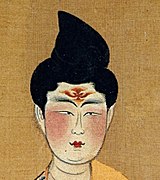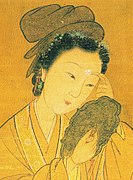|
Huadian (make-up)
Huadian (traditional Chinese: 花鈿; simplified Chinese: 花钿), also known as huazi (Chinese: 花子; lit. 'Little flower'),[1] mianhua (Chinese: 面花), meizi (Chinese: 媚子),[2] plum blossom makeup[3] or plum makeup[4] (Chinese: 梅花妝; pinyin: méihuāzhuāng or Chinese: 落梅妝; pinyin: luòméizhuāng) or Shouyang makeup[3] (Chinese: 壽陽妝), is a form of traditional Chinese women's ornamental forehead makeup,[3] which is located between the eyebrows[5][6] and sometimes on the cheeks,[1] the temples,[7] and the dimples.[8] According to a folklore legend, the huadian in floral shape originated in the Southern dynasty period;[3] its creation is attributed to Princess Shouyang,[9][6] a daughter of Emperor Wu of Liu Song (420 – 479 AD).[4] However, the origins of the huadian can be traced back earlier than the folklore legends to the Qin and Han dynasties,[7] and even in the pre-Qin period[10] with its customs arising as early as the Spring and Autumn period (c. 770 – 476 BC) and Warring States period (c. 475 – 221 BC) based on archaeological artifacts and studies.[11][2] Its origins has no connection with the diandan (Chinese: 点丹; lit. 'Dot Cinnabar'), i.e. Baihao (Chinese: 白毫), found on the middle forehead of Buddha statue.[12] The huadian was also popular among Tang and Song dynasties' women.[3] The popularity of the huadian declined in the Yuan dynasty.[7] The huadian forms an integral part of Chinese clothing culture.[13] In present days, huadian is often combined with the wearing of hanfu, the traditional clothing of the Han Chinese.[8] Designs and coloursThe huadian come in various different shapes and patterns,[1] including flowers, plum blossoms, butterfly, coins, peaches, birds, phoenixes and other animals.[3][8][14] It is typically red in colour but can also be found in different colours, such as green and gold.[8] Different materials such as emerald bird feathers / cuidian (Chinese: 翠鈿), gold leaf, silver leaf, paper, fish scales, feathers, pearls, jewels, dragonfly wings can be used.[8][1] Application locationThe huadian is typically applied on the forehead[3] between the eyebrows;[5][6] sometimes, it is applied on the cheeks,[1] on the temples,[7] and even on the dimples where this form of make-up became referred as mianye (Chinese: 面靨).[8] Mianye were typically about 1 cm from each sides of the lips and were red in colour.[3] During the prosperous period of the Tang dynasty and the Five Dynasties and Ten Kingdoms period, the mianye reached high up to the two sides of the nose.[3] HistoryThe customs of applying early prototypes of the huadian can be traced back to the Pre-Qin period;[10] for examples, female figurines unearthed from the tomb of Chu dating to the Warring States period in Changsha, Hunan province, have decorative shapes or patterns painted on their face, which shows that the prototypes of the huadian already existed much earlier than the folk legends.[11][2] Northern and Southern dynasties According to a legend, the huadian in floral design originated in the Southern dynasty period when a plum blossom was blown on the forehead of Princess Shouyang (a daughter of Song Wudi[4]) when she was taking a walk in the palace in early spring.[3] The plum blossom for some reasons could not be removed or washed off; but since it looked beautiful on the princess, it became a fashion trend.[3] Another legend says that Princess Shouyang was taking a nap when a plum blossom fell on her forehead (and cheeks[14]) leaving imprints;[15][4] these imprints stays for three days.[14] The effect of the flower imprint was so striking that it formed a new vogue and was copied by other ladies.[15][4] This fashion trend soon became popular across the country.[14] Tang dynasty and Five dynasties and Ten Kingdoms periodAccording to the Youyang zazu (酉陽雜俎), women in the Tang dynasty painted huazi (Chinese: 花子) on their face, which originated from Shangguan Wan'er.[11] According to the Chinese folk legend, the red plum blossom huadian became popular in the Tang dynasty under the influence of Shangguan Wan'er. Shangguan Wan'er had her face ruined by Wu Zetian with a scar on the forehead, and as a result, she tattooed a red plum blossom around her scar and dyed it red taking inspiration to the plum blossom makeup created by Princess Shouyang.[16] The red plum blossom not only covered her scar but also made her look more beautiful and charming, which in turn made the makeup popular from the palace ladies to the common folk turning it into a representative makeup of the Tang dynasty.[16] This became known as Hongmei zhuang (Chinese: 紅梅妝; lit. 'Red Plum Makeup'). In the Tang dynasty, the huadian could also be painted or made of tiny pieces of metal,[6] such as gold or silver foil.[5] Other materials such as paper, fish scales or dragonfly wings were also used to make the huadian.[5] During this period, there were more than 10 variations of plum blossoms which were used as facial adornment.[14] Bird, snake and lead-shaped decorations were also popular.[14] During the prosperous period of the Tang dynasty and the Five Dynasties and Ten Kingdoms period, the mianye reached high up to the two sides of the nose, and they were shaped in the form of coins, peaches, birds, and flowers.[3]
Song dynastyIn the Song dynasty, huadian embellished with pearls became popular.[8]
21st centuryIn the 21st century, the huadian typically do not appear on women's face as daily makeup. However, the traditional pattern design of huadian is still used in the designs of contemporary wedding accessories and large shows.[8] The huadian is also used as a form of makeup for women when wearing hanfu.[8] It is also depicted in many Chinese television drama.[8] Nowadays, the huadian can either be painted or be applied on the face in the form of commercialized temporary tattoos. Not to be confused withSee alsoReferences
|
||||||||||||||||||||||||||||||||||||||||||||








